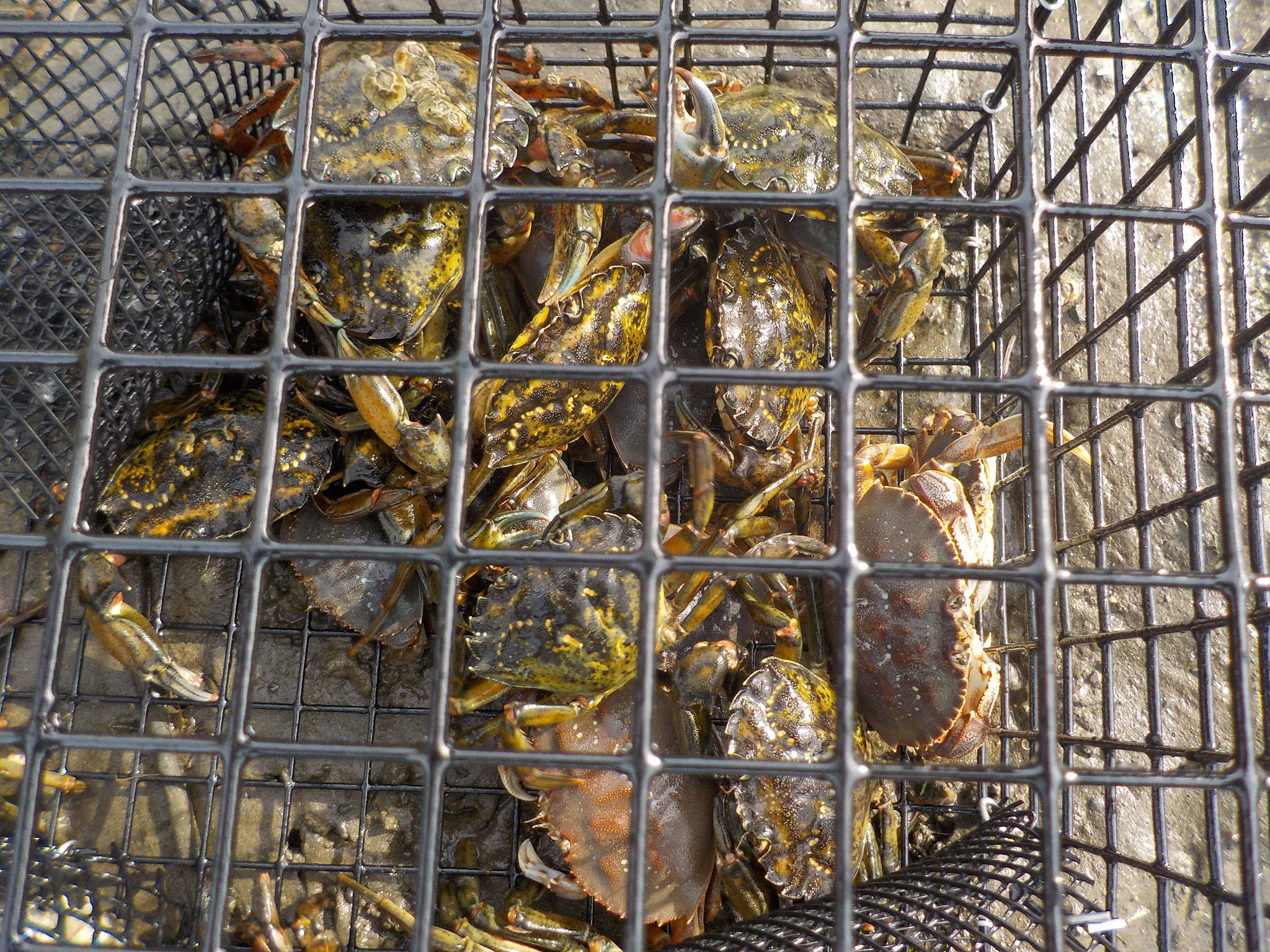As concerns over COVID-19 keep humans indoors, it’s also keeping resource managers across the Olympic Peninsula and Western Washington from continuing their fight against the invasive European green crab.
These partners continue efforts to capture and eradicate the species known worldwide for out-competing other crustaceans like Dungeness Crab and eliminating eelgrass beds.
However, along with many agencies across the state, resource managers have seen their efforts postponed because of state mandates to limit the spread of coronavirus.
Emily Grason, a marine ecologist and the University of Washington’s Crab Team program manager, said March is their busiest month of the year prepping for trapping in April-October.
“Official tracking and monitoring starts in April and as of now because of the governor’s Stay at Home order we’re holding off on sampling through at least through April 9,” she said.
“When those are lifted, hopefully most of our volunteers are ready to go and there are good tides.”
Last year, green crab maintained a prevalent presence on the Olympic Peninsula with 1,262 caught in Neah Bay by the Makah Tribe from April 1-Oct. 2. It’s their highest total since starting to trap in 2017 on the Tsoo-Yess River, Wa’atch River and near Tsoo-Yess Beach.
At the Washington National Wildlife Refuge in Dungeness, staff and volunteers caught 57 in 2019, the lowest total since green crabs were first discovered in 2017. Preventative trapping began along the Dungeness Spit in 2001.
Jamestown S’Klallam Tribe staff caught two green crabs in Sequim Bay last year, too. Green crabs were last captured in Jefferson County in 2018 but early detection sites continued.
Off the peninsula last year, resource managers found four green crabs in Samish Bay, five in Whatcom County and one on San Juan Island. Evidence of green crabs in Drayton Harbor near Blaine led to intense trapping over a two-day rapid response plan to trap 17 green crabs in late September as well.
At the time, Allen Pleus, Washington Department of Fish and Wildlife aquatic invasive species unit manager, said, “Finding this many invasive green crabs so quickly in one area raises a serious concern that there may be an established and reproducing population in Drayton Harbor.”
Opportunities
With trapping postponed to at least mid-April, there could be some prime times missed to capture green crab, some resource managers say.
Grason said data from Dungeness shows its trapping efficiency is from late April to early May in the last three years.
Lorenz Sollmann, deputy project leader for the Washington Maritime National Wildlife Refuge Complex, said the facility remains closed through at least April 8.
However, a volunteer repaired and cleaned field equipment in the winter and crab bait is in the freezer.
“The state’s Shelter-in-Place Order is currently through April 8 and we will follow that guidance,” he said. “We rely heavily on volunteers to help with the removal of this invasive species, and when it’s safe to do so, we look forward to getting our dedicated volunteers back out in their boots trapping to remove this invasive species.”
Pleus said WDFW staff suspended field work for now due to the Stay at Home order, too.
New efforts in Drayton Harbor are also on hold for training, Grason said.
“We never want a window of opportunity to slip by, but we want to keep everybody safe,” she said.
Many early detection sites are operated by older retirees, who may be more susceptible to the coronavirus because of their age.
“We’re not asking people to do anything they’re uncomfortable doing, and any participation is elective,” Grason said.
Efforts to establish more early detection sites along coastal areas are on hold until staff and volunteers can go to those areas, too.
In Neah Bay, the state’s heaviest capture area, Adrianne Akmajian — a marine ecologist for the Makah Fisheries Management — said she might not trap until May at the earliest..
Staff are working from home, but Akmajian might try to set some traps on her own this month.
“Things are so unknown right now that I hope we are able to meet all of our objectives, but I think we really don’t know what to expect,” she said.
One bright spot, Akmajian noted, is staff see higher catch rates starting in mid-May as temperatures warm up compared to April.
More info
While some areas are closed to public access for the time being, resource managers say if you find a live green crab or its shell in Washington, report it online to crabteam@uw.edu, but leave the crab in place to avoid accidentally killing native crabs.
It is illegal to possess a live green crab in Washington to protect native crabs from cases of mistaken identity.
For more information about crab identification, visit wsg.washington.edu.
For more about aquatic invasive species, visit wdfw.wa.gov/species-habitats/ invasive.
Reach Matthew Nash at mnash@sequimgazette.com.


